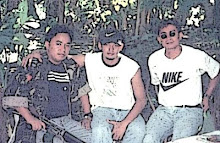
As the sun goes down in the evening, step outside and look southwest to see a celestial phenomenon. We wont see this spectacle for another 44 years, because next they'll gather like this will be on November 18, 2052.
You’ll find the bright planets Venus and Jupiter near the place the sun went down, with a waxing crescent moon nearby. They’re low in the sky – but beautiful both November 30 and December 1. With the exception of the sun and moon, Venus is the brightest light in the heavens, and Jupiter is second-brightest.
The Venus/Jupiter conjunction happens when these objects have the same right ascension on the sky’s dome. It’s as if they cross the same line of longitude in the sky and – for a brief time – beam north and south of one another on the sky’s dome. A conjunction of the two brightest planets won’t happen again until March of 2012. During this particular Venus and Jupiter conjunction, these two brilliant worlds appear 2 degrees apart. That’s about the width of your finger at an arm length away.
It’s possible – but extremely rare – to see two planets appear to merge into a single point of light. The last time two planets met up at the same spot on the sky’s dome was in the year 1818, when Venus passed in front of Jupiter. Tonight and tomorrow night, look for Venus, Jupiter, and the crescent moon in the west after sunset.
Conjunctions of two planets are fairly common. The planets often meet and appear close together the sky’s dome. But an occultation – or covering over – of one planet by another is very rare. Two planets won’t meet again on the sky’s dome for another 247 years – or until Venus occults Jupiter in the year 2065.
The Venus/Jupiter conjunction in right ascension takes place on November 30, 2008 at 7 p.m. Central Time (1:00 Universal Time on December 1).






No comments:
Post a Comment